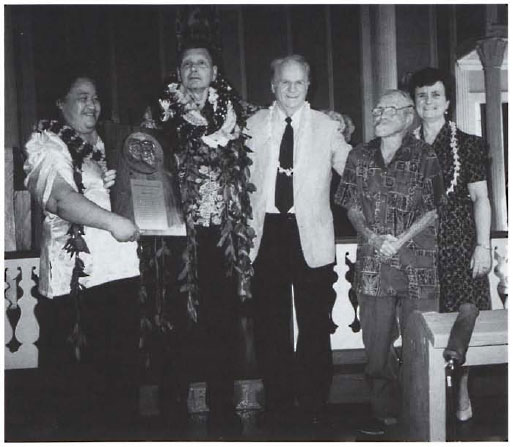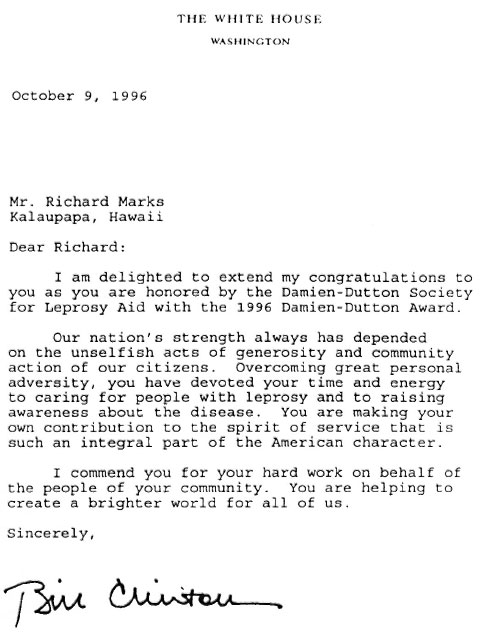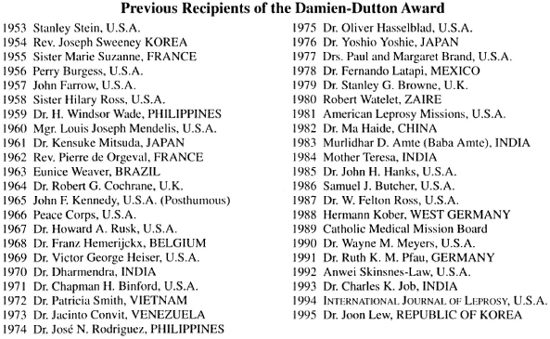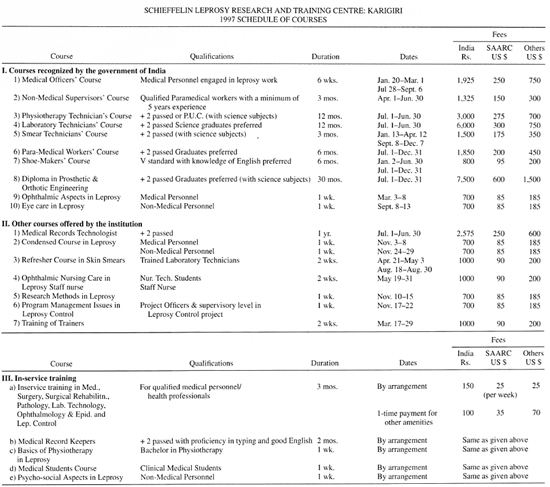- Volume 65 , Number 1
- Page: 105–15
News and notes
This department furnishes information concerning institutions, organizations, and individuals engaged in work on leprosy and other mycobacterial diseases, and makes note of scientific meetings and other matters of interest.
1996 DAMIEN-DUTTON AWARD

Award presentation (1 to r) Gloria Marks, wife of Richard Marks; Richard Marks, 1996 Award recipient; Howard Crouch, President and Founder, Damien-Dutton Society; Kenso Seki. a patient when Brother Dutton was at Kalawao; Elizabeth Campbell, Vice President. Damien-Dutton Society.
On October 10, 1996 the Damien-Dutton Award was presented to Richard Marks, a patient at the Leprosy Settlement at Kalaupapa, Molokai. The presentation was made by Howard E. Crouch, Founder and President of the Society, accompanied by Elizabeth Campbell, Vice President, and John Campbell, Member of the Board.
Richard at age 19, along with other members of his family, was diagnosed with leprosy and consigned to the Settlement. Richard ran away and joined the Merchant Marine, only later to be apprehended and sent to the Settlement. His disease was arrested with the sulfone drugs but Richard remained with other members of his family. Overcoming his adversities he started "Damien Tours." He escorts visitors to the various places of interest on Kalaupapa and Kalawao, where the patients were originally sent to fend for themselves and where Father Damien later arrived to care for them followed by Brother Dutton and others. These tours have brought the attention of the world to the Settlement, and Richard has been engaged for many years in fighting for patients' rights. He was also instrumental in the establishment of the National Park which is now located there. He is the appointed Sheriff and the ex-officio Mayor of the Settlement. Richard is known widely throughout the Hawaiian Islands and many dignitaries were in attendance at the ceremony, including the Majority Speaker of the Senate, Rosalyn Baker, and the Speaker of the House, Joseph Souki of the state of Hawaii. Messages poured in from all over including Senators Inouye and Akaka and Representatives Abercrombie and Mink. Barbara Williams, the wife of Robin Williams who is scheduled to play the role of Damien in an upcoming movie on his life to which Richard has been assigned as Technical Advisor, sent a special letter. Among the many messages were those from Mother Teresa and President Clinton (shown above).

Richard is only the second patient since the inception of the Award to be a recipient, the first being Stanley Stein, in 1953, a patient at Carville, Louisiana, who was also recognized for this efforts on behalf of the patients and was the founder of THE STAR.
The Award is given annually to a person or a group of persons who have made a significant contribution to the conquest of leprosy, either by direct patient care, research, education, social rehabilitation or philanthropy.

India. Dr. B. R. Chatterjee presents 13th Erwin Stindl Memorial Oration. The 13th Erwin Stindl Memorial Oration was held on 2 September, 1996 at GRE-CALTES Training Centre, in Calcutta. Dr. B. R. Chatterjee, the current President of the Indian Association of Leprologists, delivered the Oration on the topic "Natural History of Leprosy, MDT and Leprosy Elimination."
The oration was well attended by leprosy workers including doctors from the government, nongovernmental organizations, and the School of Tropical Medicine, Calcutta.-Materials from Dr. D. S. Chaudhury
Equipment donation for leprosy research. Mr. Dietrich Granow, Consul General of Germany, and Mrs. Elinor Mirza, Economic Attachée, Consulate General, visited the Bombay Leprosy Project (BLP) on 24 September 1996 to give sophisticated equipment, a computer system, etc., which will be used in tunc with the "high-tech" advances in developing training materials at the documentation center of the BLP and toward leprosy research. Dr. R. Ganapati, Director, BLP, demonstrated how these pieces of equipment are proposed to be used as a device for the rehabilitation of selected handicapped patients as well.
Mr. Granow released a book entitled Bombay Leprosy Project-As Others See Us which documents the views of the innumerable visitors to the BLP over the past two decades, and appreciated the commendable work in the areas of practical research undertaken by BLP. The function was a part of the series of celebrations to mark the 20th anniversary of the BLP.- Materials from Dr. R. Ganapati
14th Annual Conference Indian Academy of Neurosciences. The 14th Annual Conference of the Indian Academy of Neurosciences was hosted by The Foundation for Medical Research and was held in Bombay from February 8-10, 1996 at Jivaraj Mehta Hall, King Edward Memorial Hospital Campus, Parel.
The Conference was attended by over 80 delegates from India and abroad. There was also an enthusiastic participation by several postgraduate students and teachers from the Department of Life Sciences, University of Bombay.
The inaugural function was held on the evening of 8 February. In the opening remarks. Dr. Noshir Antia, Trustee and Director of The Foundation for Medical Research (FMR) and Chairman, Local Organizing Committee, extended a cordial welcome to all the delegates and dignitaries. He thanked the office bearers of the Neuroscience Academy for entrusting FMR with holding the 14th Annual Conference. Dr. Antia also highlighted the role and the interest of the host institute during the past 25 years in understanding the problem of leprous neuropathy which began with surgery and rehabilitation and evolved into a full-Hedged research set up, including the pathology, immunology and biochemistry of leprous neuritis.
The keynote address was delivered by Dr. Prakash Tandon, doyen of Indian neuroscience. Speaking on the future of neuroscience in India, he mentioned that neuroscience research is a continuum of study from molecule to behavior and encompasses that body of research directed toward understanding the molecular, cellular and intracellular process in the nervous system and the way these processes are integrated to subserve behavior and function.
Dr. Bachhawat, in his presidential address, stressed the importance of close collaboration between neuroscientists in India to make it more meaningful. The history and development of the Indian Academy of Neurosciences was aptly presented by'Prof. K. C. Singhal, Secretary of the organization. The inaugural function came to an end with a vote of thanks by Dr. V. P. Shetty, Secretary, Local Organizing Committee.
February 9 and 10 were fully devoted to scientific programs. Some of the eminent scientists who made their contribution to the conference were: Dr. Harish Pant, Laboratory of Neurochemistry, National Institutes of Health, Bethesda, Maryland, U.S.A., gave a guest lecture on neurofilaments in health and disease. Dr. Sudhir Gupta, University of California, Irvine, California, U.S.A., spoke on current uses and molecular mechanisms of intravenous immunoglobulin in immunological disorders. Dr. Satu Somani, Department of Pharmacology, Southern Illinois University School of Medicine, Carbondale, Illinois, U.S.A., delivered a lecture on brain response to exercise-role of antioxidants. The eminent Indian neurobiologist Dr. Obaid Siddique spoke on the neurobiology of drosophila-lessons for man. Dr. R. C. Srimal, Director, Industrial Toxicology Research Centre, Lucknow, India, covered a topic on neurotoxicity to drugs and environmental chemicals. Dr. K. C. Singhal spoke on pharmaco-epidemiology of adverse drug reactions, and Dr. Mahdi Hasan spoke on the ultrastructural evidence for perturbation of the blood brain barrier in hydrocephalic children.
Besides free papers, posters and awardwinning papers, three symposia were held on topics that constituted the frontier of neuroscience and also were relevant to Indian conditions. The first symposium was on mycobacteria and the nervous system in which two mycobacterial diseases, tuberculosis and leprosy, were discussed. This symposium was a central focus in view of the long-standing interest of the FMR in pursuing the study of peripheral neuropathy in leprosy, including understanding the mechanism and the prevention and management of leprous neuropathy. It is felt that this could serve as a model for several other neurological disorders. The contributors to this symposium were Dr. Nadir Bharucha (Bombay), Dr. Chandramukhi (NIMHANS, Bangalore), Drs. V. P. Shetty, N. F. Mistry and T. J. Birdi (FMR, Bombay). This symposium was financed in part by the Indian Council of Medical Research.
The second symposium was on neurodegeneration and neuronal plasticity. Contributors to this symposium were Dr. S. K. Shankar (NIMHANS, Bangalore), Dr. J. N. Sinha (Lucknow), Dr. K. T. Shetty (NIMHANS, Bangalore) and Dr. M. I. Sabri (U.S.A.). This symposium was fully supported by the Council of Scientific and Industrial Research.
The third symposium was on neurotrophic factors and cell death. The contributors for this symposium were Dr. Praveen Anand (London), Dr. V. S. Lalitha Rao (ex-CRI, Bombay), Dr. Ashok Vaidya (Bombay), and Dr. P. K. Mohan Kumar (Calcutta). The width of the topics covered in the symposia reflected a global effort in tackling infectious and neurodegenerative disorders.
On the last day, the last guest lecture that came as a bonus was by Dr. John G. Nicholls, Department of Pharmacology, University of Basel, Basel, Switzerland.
The topic was regeneration of the immature mammalian spinal cord after injury. Elegantly delivered with ease and humor it was a lesson in how to give a talk.
The Conference, although formulated with modest funding, nevertheless provided a unique opportunity for a dialogue between laboratory scientists, students, teachers and physicians on the structure and function of the brain and the nervous system in health and disease.-Materials from Dr. N. H. Antia
1997 Schieffelin courses at Karigiri, The Schieffelin Leprosy Research and Training Center, Karigiri, has announced the following course schedule for 1997 (pp. 110-111).
Facilities include a hostel (60 men, 16 women) and guest house (single or double rooms).
Courses demand fluency in English and are recognized by WHO and the Indian government (all paramedical technical courses are fully recognized by the Indian government).
How to reach Karigiri: Madras is connected to all major cities of India by air. From Madras Airport the fare for a taxi is approximately Rs.8()0/-. Route is to Ranipet → Tiruvatam → Sevoor → Karigiri. There are also many buses which operate between 05.00 hrs and 22.00 hrs from Madras to Vellore; from Vellore take any taxi or auto which costs Rs.150/- and Rs. 100/-, respectively, or else you can take a prepaid taxi or electric train to the City Railway station (Central Station) about 20 kins away from the airport. From there take any train to Katpadi Railway Station (13 kms away from Karigiri). From Katpadi to Karigiri an auto will cost Rs.75/-. If you want to be met at Katpadi or at the Madras Airport, please let us know well in advance.
Mailing address: Director or Registrar, Training Unit, S.L.R.&T. Center, Karigiri 632 106, N.A.A. District, Tamil Nadu, South India.
Telephone: 91-416-74227, 74229, 74251; Telegram: "LEPSEARCH" Vellore-7; FAX: 91-416-74274 or 91-416-32103.
For further information, contact Mr. T. Jayarajan, Registrar, Schieffelin Leprosy Research & Training Center, 632 106 Karigiri, Tamil Nadu, India. Tel: 91-416-74227, 74229, 74221, (Director); FAX: 91-41632103 or 91-416-71274.-Materials from Dr. P. S. S. Sundar Rao, Director, S.L.R.&T.
Japan. Japanese Leprosy Association changes name. In The Star, March/April 1995, Vol. 54, No. 4, we reported The Japanese Leprosy Association's view on The Leprosy Prevention Law, proposed at its 68th general meeting on 22 April 1995. The view stated that the measures for Hansen's disease in Japan, aimed at the lifelong segregation of all patients, are a serious mistake and that The Leprosy Prevention Law, which authorized the measures, was not needed from the first. It also stated that the Association regretfully admitted its overlooking those facts.
This honest reconsideration of The Japanese Leprosy Association was taken as an exception in the medical world, and caused great shock waves. The Japanese Ministry of Health and Welfare began moving toward the abolition of the law. On 27 March 1996, the Diet passed a bill abolishing The Leprosy Prevention Law. On and after 1 April, the name of the disease "leprosy" was ousted from all laws with "Hansen's disease" taking its place. In addition to that, "National Leprosariums" came to be "National Hansen's Disease Sanatoriums."
Prior to this, in October 1995, the organization of the Hansen's disease patients in Japan (Zen-Kan-Kyo) had requested The Japanese Leprosy Association to authorize the name "Hansen's disease" instead of "leprosy" and to change the name of the Association to "The Japanese Hansen's Disease Association." The Affairs Secretary of the association, Minoru Narita, responding to the patients' hate of the name "leprosy" [the patients in Japan call their disease "hon-byo" (the disease); similarly, the Gillis W. Long Hansen's Disease Center uses the term "the disease"], as well as regarding the view proposed at the 68th general meeting with reconsideration of the Association's responsibility to the patients, conducted a questionnaire on members' pro and con opinions concerning the request. All 255 members of the Association received the questionnaire and 62% of them replied; 84% of the answers were in favor of the request.
On 26 April 1996, at the 69th general meeting of The Japanese Leprosy Association at Okayama, President Osamu Onoue presiding, the Affairs Secretary of the Association presented proposals as follows. Although there was some controversy, the following were agreed on for the present:
1. The Association accepts the change of the name of the disease from "leprosy" to "Hansen's disease."
2. With the change of the name of the disease to "Hansen's disease," the Association organizes a Committee for the Examination of Language to examine the propriety of changing the medical terminology related to "leprosy" and to submit proposals to the next general meeting.
3. The Japanese Leprosy Association changes its name to "The Japanese Hansen's Disease Association" The Association organizes a Committee for Examination of Regulations to discuss modification of the regulations and to submit a plan to the next general meeting.
4. Aiming at the spread of the correct information concerning Hansen's disease, the Association organizes a Committee for Public Education to make concrete plans and to carry them into practice.
As for the chairmen of the Committees mentioned above, the President nominated three members of the Association. They are as follows: Chairman of the Committee for Examination of Language = Hajime Saito, Director General, National Institute for Hansen's Disease (Leprosy) Research; Chairman of the Committee for Examination of the Regulations = Eiichi Matsuo, Professor, Kyorin University; Chairman of the Committee for Public Education: Hiroshi Nakajima, Professor, Yokohama City University.
On 12 June 1996, the Association received a notice from the Japanese Medical Association that the change of the name of the subassociation #35 was acknowledged as an interim measure and is due to be resolved at the meeting of the Board of Trustees of The Japanese Medical Association held in February of 1997.
Reported and translated by: Y. Fukunislii, M.D., Director General, Matsugaoka Hoyouen, Japan, and K. Nagata, B.A., Koganei, Japan.-Materials received from Dr. Y. Fukunislii and Dr. M. Narita
Turkey. Istanbul to host international meeting. Prof. Dr. Turkan Saylan writes that an international meeting entitled "Where arc we in the fiiiht against leprosy while approaching 2000?" will be held 27-30 April 1997 in Istanbul, Turkey. He invites all leprosy workers who have spent their last 20-30 years in the direct fight against leprosy to discuss the past, present, and the future of the leprosy struggle. Guest speakers who have confirmed their participation include: J. G. Andersen, J. W. Brandsma, T. ffytche, S. D. Gokhale, M. Karacorlu, K. U. Kiran, A. C. McDougall, S. K. Noordeen, T. Ozkan, T. J. Ryan, and T. Saylan. Those who wish to participate should immediately contact: Dr. Tulay Cakiner, Istanbul Lepra Hastanesi, Bakirkoy, 34747 Istanbul, Turkey. Tel: 90-212-570-2575: Fax: 90212-583-0086.
FIFTEENTH INTERNATIONAL LEPROSY CONGRESS
Beijing, People's Republic of China 7-12 September 1998
Message from the ILA president
The first International Leprosy Congress held in Berlin in 1897 opened the era of modern leprosy control. The first century of that period is now closing, with gratifying reduction in the global leprosy burden. However, there is much more to be done. We must keep leprosy, as an infectious disease, firmly under control. More significantly, we must strengthen and improve measures to deal with leprosy as a disability producing disease. These are tasks we must still face in the second century of our modern fight against leprosy.
The 15th and "Centennial" Congress is being organized under the main theme of "Working toward a World without Leprosy." The members of our association have been the main force behind the great achievements so far, and no doubt will remain so in the new century. The last few congresses have become much more than a meeting of our members, non-member participants outnumbering members two or even three to one. These are mostly field workers, both medical and nonmedical, of the leprosy-endemic countries. Their share of responsibilities are bound to increase. The International Leprosy Congress intends to meet their interests and needs as much as those of our own members.
I extend my cordial invitation to all those interested and concerned in solving leprosy problems. Let us make the Beijing Congress an opportunity to renew our commitment to eradicate leprosy during the next century.
Yo Ynasa
President
Message of welcome
I am honored to express our warm welcome to the distinguished specialists, scholars, field workers and others who will participate in the forthcoming centennial Congress.
The Chinese government has attached great importance to leprosy control. We have made significant progress by the joint efforts of the governments at each level and numerous health workers in leprosy control, by persevering implementation of the strategy "Active Prevention and Intensive Treatment for the Control of the Infection Sources" and by adopting a set of approaches to comprehensive control with Chinese characteristics during the last 40 years.
The governmental organizations and non-government organizations of various countries as well as international organizations, including WHO, ILA, and ILEP, have provided sincere and effective assistance and cooperation for leprosy control in China. I would like to take this opportunity to convey my cordial appreciation to them all on behalf of the Chinese government and the Chinese people.
The Chinese government and the Ministry of Health are paying great attention to this Congress. Being the host country, we will cooperate closely with the ILA in providing enthusiastic services so as to make this Congress a united, friendly, cooperative and successful one. We will make our efforts to contribute to the global elimination of leprosy in the next century.
Beijing, the capital of China, is a famous cultural city with a long history. It possesses magnificent historic interests and beautiful scenery. The autumn in Beijing is mild and delightful. I wish for all the participants a memorable time in Beijing.
Prof. Yin Dakui
Vice Minister, Ministry of Health
People's Republic of China
GENERAL INFORMATION
Dates
7-12 September 1998
Location
Beijing International Convention Center
Beijing, People's Republic of China
Congress Language
English
Posters/Exhibition Space
Posters illustrating participants' work and research will be on exhibit throughout the Congress. In addition, paid exhibit space can be reserved for product or organization displays. For exhibit space costs and information, write separately to the Secretary for Administration
Registration/Fees/Call for Scientific Abstracts
For additional information on fees, registration, and submission of abstracts, and to receive the 2nd (final) announcement, contact:
Secretariat
15th International Leprosy Congress c/o Sasakawa Memorial Health
Foundation
3-12-12 Mita
Minato-ku
Tokyo 108, Japan
Free Communications
A book of abstracts will be part of each registration packet
Social Events/Tours
A reception and dinner will be held for Congress participants
Congress Issues
Presentations and discussions at the Congress will be organized around three groups of issues related to the theme of the Congress "Working toward a World without Leprosy." They are: the control of the disease, including the progress toward elimination of leprosy as a public health problem and sustainability of the control service after that, social aspects of rehabilitation, and causative organism and host response. Each group of issues will be dealt with by keynote addresses, panel discussions, workshops and consensus-forming sessions, in addition to oral and poster presentations of individual papers in concurrent sessions. Maximum opportunities will be given to the Congress participants to interact at various plenary sessions.
[There will be no pre-Congress workshops.]
Poster Sessions
Special attention will be given to poster presentations in order to maximize the personal discussions and explanations of participants' research and work. The Organizing Committee will provide a well-planned schedule of poster presentations during the Congress in connection with Congress themes.
Teaching & Training Sessions
Teaching sessions will be held on Tuesday, Wednesday and Thursday evenings at the Convention Center.
Exhibits
Exhibitions will be arranged for organizations or institutions wishing to display teaching and learning material, including books, video tapes and compact discs, footwear, medical supplies and equipment and other items of interest to participants. If you plan to exhibit, please request information from the Secretariat.

